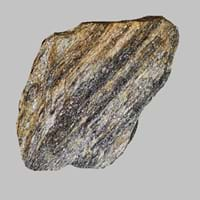Mylonite and Tonalite
Definition
Definition
Mylonite is a metamorphic rock formed by ductile deformation during intense shearing encountered during folding and faulting, a process termed cataclastic or dynamic metamorphism
Tonalite is a coarse-grained plutonic rock consisting mainly of sodic plagioclase, quartz, and hornblende or other mafic minerals with phaneritic texture
History
Origin
New Zealand
Tonale, Italy
Discoverer
Unknown
Unknown
Etymology
From Greek mulōn mill + -ite
From Tonale Pass, northern Italy, + -ite1
Class
Metamorphic Rocks
Igneous Rocks
Sub-Class
Durable Rock, Medium Hardness Rock
Durable Rock, Hard Rock
Family
Group
Not Applicable
Plutonic
Other Categories
Fine Grained Rock, Opaque Rock
Coarse Grained Rock, Fine Grained Rock, Medium Grained Rock, Opaque Rock
Texture
Texture
Foliated
Phaneritic
Color
Black to Grey
Black, Brown, Light to Dark Grey, White
Maintenance
Less
Less
Durability
Durable
Durable
Water Resistant
Yes
Yes
Scratch Resistant
Yes
Yes
Stain Resistant
No
Yes
Wind Resistant
No
No
Acid Resistant
No
Yes
Appearance
Dull, Banded and Foilated
Banded and Foilated
Uses
Architecture
Interior Uses
Decorative Aggregates, Interior Decoration
Decorative Aggregates, Entryways, Flooring, Homes, Interior Decoration
Exterior Uses
As Building Stone, As Facing Stone, Paving Stone, Garden Decoration
As Building Stone, As Facing Stone, Paving Stone, Garden Decoration, Office Buildings
Other Architectural Uses
Curbing
Curbing
Industry
Construction Industry
for Road Aggregate, Landscaping, Roadstone
As Dimension Stone, Cement Manufacture, Cobblestones, Construction Aggregate, for Road Aggregate
Medical Industry
Not Yet Used
Not Yet Used
Antiquity Uses
Artifacts, Monuments
Artifacts, Sculpture
Other Uses
Commercial Uses
Creating Artwork, Gemstone, Jewelry
Cemetery Markers, Creating Artwork
Types
Types
Blastomylonites, Ultramylonites and Phyllonites
Dacite
Features
Surfaces are often shiny
Is one of the oldest rock, Typically speckled black and white.
Archaeological Significance
Monuments
Used
Not Yet Used
Famous Monuments
Data Not Available
Not Applicable
Sculpture
Used
Used
Famous Sculptures
Data Not Available
Data Not Available
Pictographs
Used
Not Used
Petroglyphs
Used
Not Used
Figurines
Used
Used
Fossils
Absent
Absent
Formation
Formation
Mylonites are ductilely deformed rocks formed by the accumulation of large shear strain, in ductile fault zones.
When alkali feldspar is extracted from granite, it changes to granitoid and later, it becomes tonalite with quartz as major mineral.
Composition
Mineral Content
Porphyroblasts
Albite, Amphibole, Apatite, Biotite, Feldspar, Hornblade, Ilmenite, Magnetite, Manganese Oxides, Olivine, Plagioclase, Pyroxene, Quartz, Sulfides, Titanite, Zircon
Compound Content
Aluminium Oxide, Calcium Sulfate, Chromium(III) Oxide, Iron(III) Oxide, Magnesium Carbonate, Silicon Dioxide
NaCl, CaO, MgO, Silicon Dioxide
Transformation
Metamorphism
No
Yes
Types of Metamorphism
Not Applicable
Burial Metamorphism, Cataclastic Metamorphism, Contact Metamorphism, Hydrothermal Metamorphism, Impact Metamorphism, Regional Metamorphism
Weathering
Yes
Yes
Types of Weathering
Biological Weathering, Chemical Weathering, Mechanical Weathering
Biological Weathering, Chemical Weathering, Mechanical Weathering
Erosion
Yes
Yes
Types of Erosion
Chemical Erosion, Sea Erosion, Wind Erosion
Wind Erosion
Properties
Physical Properties
Hardness
3-4
6-7
Grain Size
Fine Grained
Medium to Fine Coarse Grained
Fracture
Conchoidal
Conchoidal
Streak
White
Bluish Black
Porosity
Highly Porous
Very Less Porous
Luster
Shiny
Subvitreous to Dull
Compressive Strength
1.28 N/mm2
32
Not Available
Cleavage
Conchoidal
Not Available
Toughness
Not Available
2.1
Specific Gravity
2.97-3.05
2.86-3
Transparency
Opaque
Opaque
Density
2.6-4.8 g/cm3
2.73 g/cm3
Thermal Properties
Specific Heat Capacity
1.50 kJ/Kg K
3
0.92 kJ/Kg K
10
Resistance
Heat Resistant, Impact Resistant, Pressure Resistant
Heat Resistant, Pressure Resistant, Water Resistant
Reserves
Deposits in Eastern Continents
Asia
China, India, Indonesia, Saudi Arabia, South Korea
Not Yet Found
Africa
Eritrea, Ethiopia, Ghana, South Africa, Western Africa
Egypt
Europe
England, Finland, France, Germany, Great Britain, Greece, United Kingdom
Finland, Germany, Italy, Romania, Sweden, Turkey
Others
Not Yet Found
Not Yet Found
Deposits in Western Continents
North America
USA
USA
South America
Not Yet Found
Argentina, Bolivia, Chile, Colombia, Ecuador, Peru
Deposits in Oceania Continent
Australia
Central Australia, Western Australia
New Zealand, South Australia, Western Australia
All about Mylonite and Tonalite Properties
Know all about Mylonite and Tonalite properties here. All properties of rocks are important as they define the type of rock and its application. Mylonite belongs to Metamorphic Rocks while Tonalite belongs to Igneous Rocks.Texture of Mylonite is Foliated whereas that of Tonalite is Phaneritic. Mylonite appears Dull, Banded and Foilated and Tonalite appears Banded and Foilated. The luster of Mylonite is shiny while that of Tonalite is subvitreous to dull. Mylonite is available in black to grey colors whereas Tonalite is available in black, brown, light to dark grey, white colors. The commercial uses of Mylonite are creating artwork, gemstone, jewelry and that of Tonalite are cemetery markers, creating artwork.
|
||
|
||
|










